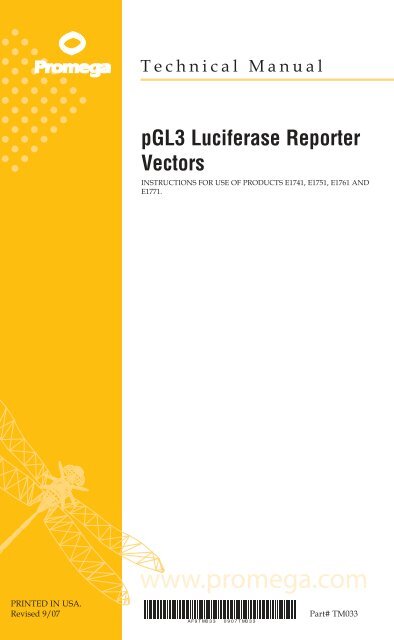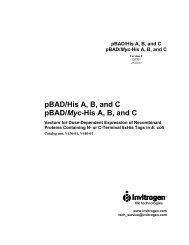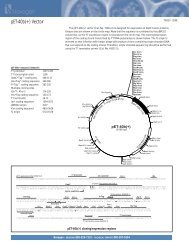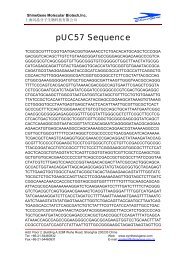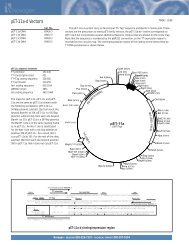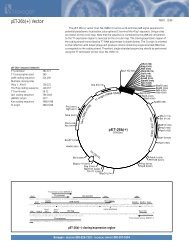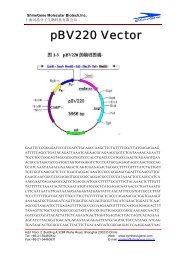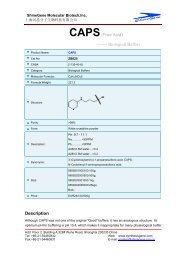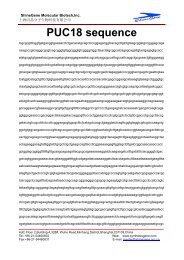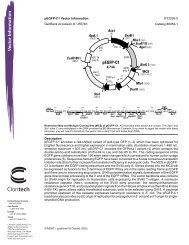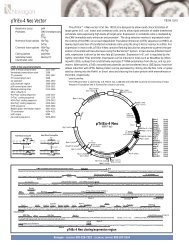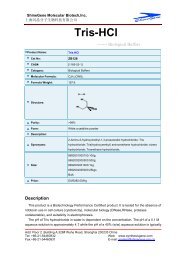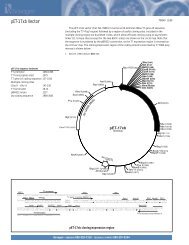pGL3 Luciferase Reporter Vectors Technical Manual #TM033
pGL3 Luciferase Reporter Vectors Technical Manual #TM033
pGL3 Luciferase Reporter Vectors Technical Manual #TM033
- No tags were found...
Create successful ePaper yourself
Turn your PDF publications into a flip-book with our unique Google optimized e-Paper software.
<strong>Technical</strong> <strong>Manual</strong><strong>pGL3</strong> <strong>Luciferase</strong> <strong>Reporter</strong><strong>Vectors</strong>INSTRUCTIONS FOR USE OF PRODUCTS E1741, E1751, E1761 ANDE1771.PRINTED IN USA.Revised 9/07AF9TM0330907TM033Part# TM033
<strong>pGL3</strong> <strong>Luciferase</strong> <strong>Reporter</strong> <strong>Vectors</strong>All technical literature is available on the Internet at: www.promega.com/tbs/Please visit the web site to verify that you are using the most current version of this<strong>Technical</strong> Bulletin. Please contact Promega <strong>Technical</strong> Services if you have questions on useof this system. E-mail: techserv@promega.comI. Description..........................................................................................................2II. Product Components and Storage Conditions ............................................2III. <strong>pGL3</strong> Vector Maps and Sequence Reference Points ..................................2A. <strong>pGL3</strong>-Basic Vector................................................................................................3B. <strong>pGL3</strong>-Enhancer Vector ........................................................................................4C. <strong>pGL3</strong>-Promoter Vector ........................................................................................5D. <strong>pGL3</strong>-Control Vector ...........................................................................................6IV. Cloning Methods ...............................................................................................7A. Cloning Strategies.................................................................................................7B. Preparation of <strong>pGL3</strong> <strong>Vectors</strong> and Insert DNA for Cloning...........................8C. Transformation Protocols for <strong>pGL3</strong> <strong>Vectors</strong> ....................................................8D. Isolation of Plasmid DNA...................................................................................8V. Transfection of Mammalian Cells..................................................................9VI. Assay of <strong>Luciferase</strong> Activity............................................................................9VII. Sequencing of <strong>Luciferase</strong> <strong>Reporter</strong> <strong>Vectors</strong>...............................................11VIII. Appendix ...........................................................................................................12A. Common Structural Elements of the <strong>pGL3</strong> <strong>Luciferase</strong><strong>Reporter</strong> <strong>Vectors</strong> ................................................................................................12B. Advantages of the <strong>pGL3</strong> <strong>Vectors</strong> .....................................................................13C. The <strong>pGL3</strong> <strong>Vectors</strong> luc+ Gene ............................................................................14D. Mapping Genetic Elements Located Within DNA Fragments....................16E. Composition of Buffers and Solutions ............................................................16F. References............................................................................................................17G. <strong>pGL3</strong>-Basic Vector Restriction Sites.................................................................18H. <strong>pGL3</strong>-Enhancer Vector Restriction Sites.........................................................20I. <strong>pGL3</strong>-Promoter Vector Restriction Sites.........................................................23J. <strong>pGL3</strong>-Control Vector Restriction Sites ............................................................26K. Related Products.................................................................................................28Promega Corporation · 2800 Woods Hollow Road · Madison, WI 53711-5399 USAToll Free in USA 800-356-9526 · Phone 608-274-4330 · Fax 608-277-2516 · www.promega.comPrinted in USA.Part# TM033Revised 9/07 Page 1
I. DescriptionThe <strong>pGL3</strong> <strong>Luciferase</strong> <strong>Reporter</strong> <strong>Vectors</strong> (a,b) provide a basis for the quantitativeanalysis of factors that potentially regulate mammalian gene expression. Thesefactors may be cis-acting, such as promoters and enhancers, or trans-acting,such as various DNA-binding factors. The backbone of the <strong>pGL3</strong> <strong>Luciferase</strong><strong>Reporter</strong> <strong>Vectors</strong> is designed for increased expression, and contains a modifiedcoding region for firefly (Photinus pyralis) luciferase that has been optimized formonitoring transcriptional activity in transfected eukaryotic cells. The assay ofthis genetic reporter is rapid, sensitive and quantitative. In addition, these<strong>Luciferase</strong> <strong>Reporter</strong> <strong>Vectors</strong> contain numerous features aiding in the structuralcharacterization of the putative regulatory sequences under investigation.II.Product Components and Storage ConditionsProduct Size Cat.#<strong>pGL3</strong>-Control Vector 20µg E1741<strong>pGL3</strong>-Basic Vector 20µg E1751<strong>pGL3</strong>-Promoter Vector 20µg E1761<strong>pGL3</strong>-Enhancer Vector 20µg E1771Information on related products, including the <strong>Luciferase</strong> Assay System, is provided inSections IV–VI and VIII.K.Storage Conditions: Store the <strong>pGL3</strong> <strong>Luciferase</strong> <strong>Reporter</strong> <strong>Vectors</strong> at –20°C.III.<strong>pGL3</strong> Vector Maps and Sequence Reference PointsThe listings of restriction sites for the <strong>pGL3</strong> <strong>Luciferase</strong> <strong>Reporter</strong> <strong>Vectors</strong> areprovided in Section VIII.G–J.Note: The specific transcriptional characteristics of the <strong>pGL3</strong> <strong>Vectors</strong> willvary for different cell types. This may be particularly true for COS cells,which contain the SV40 large T antigen. The SV40 large T antigen promotesreplication from the SV40 origin, which is found in the promoter of the<strong>pGL3</strong>-Promoter and <strong>pGL3</strong>-Control <strong>Vectors</strong>. The combination of large T antigenand SV40 origin will result in a higher copy number of these vectors in COScells, which in turn may result in increased expression of the reporter genecompared to other cell and vector combinations.Promega Corporation · 2800 Woods Hollow Road · Madison, WI 53711-5399 USAToll Free in USA 800-356-9526 · Phone 608-274-4330 · Fax 608-277-2516 · www.promega.comPart# TM033Printed in USA.Page 2 Revised 9/07
III.A. <strong>pGL3</strong>-Basic VectorThe <strong>pGL3</strong>-Basic Vector lacks eukaryotic promoter and enhancer sequences,allowing maximum flexibility in cloning putative regulatory sequences.Expression of luciferase activity in cells transfected with this plasmid dependson insertion and proper orientation of a functional promoter upstream fromluc+. Potential enhancer elements can also be inserted upstream of thepromoter or in the BamHI or SalI sites downstream of the luc+ gene.Amp rSynthetic poly(A)signal / transcriptionalpause site(for backgroundreduction)ori<strong>pGL3</strong>-BasicVector(4818bp)f1 oriKpnISacIMluINheISmaIXhoIBgIIIHindIIINcoI 862010 SalI2004 BamHIluc+NarI 121511152128323653SV40 latepoly(A) signal(for luc+ reporter)HpaI 1902XbaI 17420746VA08_4AFigure 1. <strong>pGL3</strong>-Basic Vector circle map. Additional description: luc+, cDNAencoding the modified firefly luciferase; Amp r , gene conferring ampicillin resistancein E. coli; f1 ori, origin of replication derived from filamentous phage; ori, origin ofreplication in E. coli. Arrows within luc+ and the Amp r gene indicate the direction oftranscription; the arrow in the f1 ori indicates the direction of ssDNA strandsynthesis.<strong>pGL3</strong>-Basic Vector Sequence Reference Points:Promoter(none)Enhancer(none)Multiple cloning region 1–58<strong>Luciferase</strong> gene (luc+) 88–1740GLprimer2 binding site 89–111SV40 late poly(A) signal 1772–1993RVprimer4 binding site 2080–2061ColE1-derived plasmid replication origin 2318β-lactamase gene (Amp r ) 3080–3940f1 origin 4072–4527upstream poly(A) signal 4658–4811RVprimer3 binding site 4760–4779Promega Corporation · 2800 Woods Hollow Road · Madison, WI 53711-5399 USAToll Free in USA 800-356-9526 · Phone 608-274-4330 · Fax 608-277-2516 · www.promega.comPrinted in USA.Part# TM033Revised 9/07 Page 3
III.B. <strong>pGL3</strong>-Enhancer VectorThe <strong>pGL3</strong>-Enhancer Vector contains an SV40 enhancer located downstream ofluc+ and the poly(A) signal. This aids in the verification of functional promoterelements because the presence of an enhancer will often result in transcriptionof luc+ at higher levels.Amp rSynthetic poly(A)signal / transcriptionalpause site(for backgroundreduction)2256 SalI2250 BamHIori<strong>pGL3</strong>-EnhancerVector(5064bp)f1 oriluc+KpnISacIMluINheISmaIXhoIBgIIIHindIIINcoI 86NarI 121511152128323653SV40 EnhancerSV40 latepoly(A) signal(for luc+ reporter)HpaI 1902XbaI 17420745VA08_4AFigure 2. The <strong>pGL3</strong>-Enhancer Vector circle map. Additional description: luc+,cDNA encoding the modified firefly luciferase; Amp r , gene conferring ampicillinresistance in E. coli; f1 ori, origin of replication derived from filamentous phage; ori,origin of plasmid replication in E. coli. Arrows within luc+ and the Amp r geneindicate the direction of transcription; the arrow in f1 ori indicates the direction ofssDNA strand synthesis.<strong>pGL3</strong>-Enhancer Vector Sequence Reference Points:Promoter(none)Multiple cloning region 1–58<strong>Luciferase</strong> gene (luc+) 88–1740GLprimer2 binding site 89–111SV40 late poly(A) signal 1772–1993Enhancer 2013–2249RVprimer4 binding site 2307–2326ColE1-derived plasmid replication origin 2564β-lactamase gene (Amp r ) 3329–4186f1 origin 4318–4773upstream poly(A) signal 4904–5057RVprimer3 binding site 5006–5025Promega Corporation · 2800 Woods Hollow Road · Madison, WI 53711-5399 USAToll Free in USA 800-356-9526 · Phone 608-274-4330 · Fax 608-277-2516 · www.promega.comPart# TM033Printed in USA.Page 4 Revised 9/07
III.C. <strong>pGL3</strong>-Promoter VectorThe <strong>pGL3</strong>-Promoter Vector contains an SV40 promoter upstream of theluciferase gene. DNA fragments containing putative enhancer elements can beinserted either upstream or downstream of the promoter-luc+ transcriptionalunit.2202 SalI2196 BamHIHpaI 2094oriXbaI 1934Amp r<strong>pGL3</strong>-PromoterVector(5010bp)SV40 latepoly(A) signal(for luc+ reporter)f1 oriluc+Synthetic poly(A)signal / transcriptionalpause site(for backgroundreduction)KpnISacIMluINheISmaIXhoIBgIII5111521283236SV40 PromoterHindIII 245NcoI 2780748VA08_4AFigure 3. The <strong>pGL3</strong>-Promoter Vector circle map. Additional description: luc+,cDNA encoding the modified firefly luciferase; Amp r , gene conferring ampicillinresistance in E. coli; f1 ori, origin of replication derived from filamentous phage; ori,origin of plasmid replication in E. coli. Arrows within luc+ and the Amp r geneindicate the direction of transcription; the arrow in f1 ori indicates the direction ofssDNA strand synthesis.<strong>pGL3</strong>-Promoter Vector Sequence Reference Points:Enhancer(none)Multiple cloning region 1–41Promoter 48–250GLprimer2 binding region 281–303<strong>Luciferase</strong> gene (luc+) 280–1932SV40 late poly(A) signal 1964–2185RVprimer4 binding region 2253–2272ColE1-derived plasmid replication origin 2510β-lactamase gene (Amp r ) 3272–4132f1 origin 4264–4719Upstream poly(A) signal 4850–5003RVprimer3 binding region 4952–4971Promega Corporation · 2800 Woods Hollow Road · Madison, WI 53711-5399 USAToll Free in USA 800-356-9526 · Phone 608-274-4330 · Fax 608-277-2516 · www.promega.comPrinted in USA.Part# TM033Revised 9/07 Page 5
III.D. <strong>pGL3</strong>-Control VectorThe <strong>pGL3</strong>-Control Vector contains SV40 promoter and enhancer sequences,resulting in strong expression of luc+ in many types of mammalian cells. Thisplasmid is useful in monitoring transfection efficiency, in general, and is aconvenient internal standard for promoter and enhancer activities expressedby <strong>pGL3</strong> recombinants.Amp rSynthetic poly(A)signal / transcriptionalpause site(for backgroundreduction)2448 SalI2442 BamHIori<strong>pGL3</strong>-ControlVector(5256bp)f1 oriKpnISacIMluINheISmaIXhoIBgIII5111521283236SV40 PromoterSV40 EnhancerSV40 latepoly(A) signal(for luc+ reporter)HpaI 2094XbaI 1934luc+HindIII 245NcoI 278NarI 3130747VA08_4AFigure 4. <strong>pGL3</strong>-Control Vector circle map. Additional description: luc+, cDNAencoding the modified firefly luciferase; Amp r , gene conferring ampicillin resistancein E. coli; f1 ori, origin of replication derived from filamentous phage; ori, origin ofplasmid replication in E. coli. Arrows within luc+ and the Amp r gene indicate thedirection of transcription; the arrow in f1 ori indicates the direction of ssDNA strandsynthesis.<strong>pGL3</strong>-Control Vector Sequence Reference Points:Multiple cloning region 1–41Promoter 48–250<strong>Luciferase</strong> gene (luc+) 280–1932GLprimer2 binding site 281–303SV40 late poly(A) signal 1964–2185Enhancer 2205–2441RVprimer4 binding site 2499–2518ColE1-derived plasmid replication origin 2756β-lactamase gene (Amp r ) 3518–4378f1 origin 4510–4965upstream poly(A) signal 5096–5249RVprimer3 binding site 5198–5217Promega Corporation · 2800 Woods Hollow Road · Madison, WI 53711-5399 USAToll Free in USA 800-356-9526 · Phone 608-274-4330 · Fax 608-277-2516 · www.promega.comPart# TM033Printed in USA.Page 6 Revised 9/07
RVprimer35′ . . . CTAGCAAAATAGGCTGTCCCCAGTGCAAGTGCAGGTGCCAGAACATTTCTCTATCGATASV40PromoterGGTACCGAGCTCTTACGCGTGCTAGCCCGGGCTCGAGATCTGCGATCTAAGTAAGCTTGG . . .KpnIAcc65ISacIMluINheIXmaISmaIXhoIBglIIHindIIIluc+ Coding RegionStartSV40EnhancerCATTCCGGTACTGTTGGTAAAGCCACCATGGAAGACGCCAAAAACATAAAG . . . (1892bp) . . . GGATCCGTCGACNcoIGLprimer2 BamHI SalICGATGCCCTTGAGAGCCTTCAACCCAGTCAGCTCCTTCCGGTGGGCGCGGGGCATGACTATCGTC . . . 3′RVprimer40756MA08_4AFigure 5. <strong>pGL3</strong> Vector multiple cloning regions. Shown are the upstream anddownstream cloning sites and the locations of the sequencing primers (GLprimer2,RVprimer3 and RVprimer4). The large primer arrows indicate the direction ofsequencing. The positions of the promoter (in the <strong>pGL3</strong>-Promoter and <strong>pGL3</strong>-Control<strong>Vectors</strong>) and the enhancer (in the <strong>pGL3</strong>-Enhancer and <strong>pGL3</strong>-Control <strong>Vectors</strong>) areshown as insertions into the sequence of the <strong>pGL3</strong>-Basic Vector. (Note that thepromoter replaces four bases [AAGT] of the <strong>pGL3</strong>-Basic Vector.) The sequenceshown is of the DNA strand generated from the f1 ori.IV.Cloning MethodsIV.A. Cloning Strategies!The restriction sites for XhoI and SalI have compatible ends, as do BglII andBamHI. Therefore, cloning into the XhoI or BglII sites upstream of luc+, or thedownstream SalI or BamHI sites, allows easy interchange of DNA insertsbetween upstream and downstream positions relative to the luciferase reportergene. Thus, positional effects of a putative genetic element may be readilytested. Cloning fragments into a single site will generally yield both possibleorientations relative to the reporter gene, making these effects also readilytestable.The other upstream restriction sites may be used for cloning. However,note that some of the sites are required for generating nested deletions(see Section VIII.D). Specifically, the KpnI or SacI site is needed to generate a3´ overhang upstream of the insert.Please refer to Sections VIII.G–J for additional information on XhoI digestion.Promega Corporation · 2800 Woods Hollow Road · Madison, WI 53711-5399 USAToll Free in USA 800-356-9526 · Phone 608-274-4330 · Fax 608-277-2516 · www.promega.comPrinted in USA.Part# TM033Revised 9/07 Page 7
IV.B. Preparation of <strong>pGL3</strong> <strong>Vectors</strong> and Insert DNA for CloningThe fragment and vector DNA should be digested with restriction enzymesthat will generate compatible ends for cloning. In some cases, the ends of theDNA fragment may require modification, either by using synthetic linkers, bya PCR amplification using primers containing sites for appropriate restrictionenzymes, or by filling in the restriction site overhangs. It may be advantageousto treat the vector DNA with calf intestinal alkaline phosphatase (CIAP; Cat.#M2825) or TSAP Thermosensitive Alkaline Phosphatase (Cat.# M9910) toremove 5´ phosphate groups, thus preventing reclosure of the vector on itselfwithout an insert. Sufficient DNA should be prepared to perform controlreactions for digestion, ligation and transformation steps.To ensure capture of the correct insert DNA, the desired restriction fragmentcan be purified by electrophoresis on an acrylamide or agarose gel and thenrecovered from the gel by one of several methods, such as using the Wizard ®PCR Preps DNA Purification System <strong>Technical</strong> Bulletin #TB118. Alternatively,unfractionated restriction fragments can be cloned into the target plasmid, andthe desired recombinant then can be identified by gel electrophoresis ofplasmid DNA.Protocols for restriction digestion, alkaline phosphatase treatment, linkerligation and transformation of competent cells can be found in MolecularCloning, A Laboratory <strong>Manual</strong> (1).IV.C. Transformation Protocols for <strong>pGL3</strong> <strong>Vectors</strong>Because the <strong>Luciferase</strong> <strong>Reporter</strong> <strong>Vectors</strong> are supplied as modified DNA, E. colihosts may be either restriction + or restriction –. The use of a recA host such asJM109 is preferred because this prevents undesirable recombination betweenthe insert and the host chromosomal DNA. A strain that has an F´ episome isrequired for ssDNA production.Grow JM109 on minimal plates (M-9) supplemented with 1.0mM thiamine-HCl prior to preparation of competent cells and transformation. This selectsfor the presence of the F´ episome.IV.D. Isolation of Plasmid DNAThe Wizard ® Plus SV Minipreps DNA Purification System (Cat.# A1340,A1470) may be used for small-scale preparation of plasmid DNA for screeningclones. DNA suitable for transfection may be purified using the PureYieldPlasmid Midipreps System (Cat.# A2492, A2495).Promega Corporation · 2800 Woods Hollow Road · Madison, WI 53711-5399 USAToll Free in USA 800-356-9526 · Phone 608-274-4330 · Fax 608-277-2516 · www.promega.comPart# TM033Printed in USA.Page 8 Revised 9/07
V. Transfection of Mammalian CellsTransfection of DNA into eukaryotic cells may be mediated by cationic lipidcompounds (2), calcium phosphate (3,4), DEAE-dextran (3,5), or electroporation(4). Transfection systems based on cationic lipids (TransFast TransfectionReagent, Transfectam ® Reagent and Tfx Reagents) and calcium phosphate(Profection ® Mammalian Transfection System) are available from Promega. Formore information on these transfection reagents, please request the TransFastTransfection Reagent <strong>Technical</strong> Bulletin (#TB260), the Transfectam ® Reagent <strong>Technical</strong>Bulletin (#TB116), the Tfx-Reagents <strong>Technical</strong> Bulletin (#TB216) or the ProFection ®Mammalian Transfection System <strong>Technical</strong> <strong>Manual</strong> (#TM012). All of thesedocuments are available on our web site at: www.promega.com/tbs/VI.Assay of <strong>Luciferase</strong> ActivityExperimental strategies using firefly luciferase may involve the analysis of afew samples per day or as many as several thousand samples per hour, andequipment used to measure luminescence may vary from inexpensive, singlesampleluminometers to high-end CCD luminometers. To support this widerange of applications, we have developed three luciferase assays with different,but complementary, characteristics: <strong>Luciferase</strong> Assay System (Cat.# E1500),Bright-Glo <strong>Luciferase</strong> Assay System (Cat.# E2610), Steady-Glo ® <strong>Luciferase</strong>Assay System (Cat.# E2510), and ONE-Glo <strong>Luciferase</strong> Assay System (Cat.#E6110). Reagent choice depends on the relative importance of experimentalformat, assay sensitivity, and luminescence duration.Table 1. Characteristics of Promega <strong>Luciferase</strong> Assay Reagents.<strong>Luciferase</strong>Bright-Glo Steady-Glo ® Assay ONE-GloReagent Reagent Reagent ReagentFormat NH or H NH or H NH NH or HProcess continuous batch bench scale batch orcontinuousNumber of Steps 1 1 4 1Sensitivity highest lower higher highSignal Half-Life ~30 minutes ~5 hours ~12 minutes ~50 minutesPrecision High High High HighestCell Lysis Time ~2 minutes ~5 minutes NA ~3 minutesmaximum maximumNH = nonhomogeneous (first create a lysate); H = homogeneous; NA = not applicablePromega Corporation · 2800 Woods Hollow Road · Madison, WI 53711-5399 USAToll Free in USA 800-356-9526 · Phone 608-274-4330 · Fax 608-277-2516 · www.promega.comPrinted in USA.Part# TM033Revised 9/07 Page 9
VI.Assay of <strong>Luciferase</strong> Activity (continued)The <strong>Luciferase</strong> Assay System has long been the standard reagent for routinelaboratory analysis. Before using this reagent, cells from which the luciferase isto be measured must be washed and lysed. This reagent was optimized forhigh sensitivity in nonhomogeneous, single-sample measurements. The<strong>Luciferase</strong> Assay System requires a luminometer fitted with injectors toefficiently measure luminescence in 96-well plates.The Bright-Glo, Steady-Glo ® and ONE-Glo Reagents were developed toperform assay reactions within multiwell plates and in the presence ofcomplete cell culture medium: no cell preparation steps such as washing orlysing are required before the luminescence reaction is initiated. All of these aresingle-step reagents, requiring only addition of the reagent before measuringluminescence. This makes them ideal reagents for efficient and precisequantitation in 96-, 384- and 1536-well plates.The Bright-Glo and Steady-Glo ® Reagents are complementary in theircharacteristics based on the inverse relationship between luminescenceduration and assay sensitivity (6). Generally, as the half-life of the luminescenceincreases, assay sensitivity decreases. The Steady-Glo ® Reagent provides longluminescence duration (changing only about 10% per hour); however, toachieve this long luminescence duration, the assay sensitivity must be reduced.This reagent was designed for experiments in which many microplates areprocessed as a batch.In contrast, the Bright-Glo Reagent provides high assay sensitivity withshorter luminescence duration (
When studying promoter functionalities, it is often desirable to include asecond reporter (e.g., Renilla luciferase) as an internal control for normalization.Plasmids derived from <strong>pGL3</strong> or pGL4 vectors can be co-transfected with Renillaluciferase vectors, such as phRL-TK, and assayed using the Dual-<strong>Luciferase</strong> ®<strong>Reporter</strong> Assay System (Cat.# E1910) or the Dual-Glo <strong>Luciferase</strong> AssaySystem (Cat.# E2920).Table 2. Characteristics of Promega Dual-<strong>Luciferase</strong> Assays.Dual-<strong>Luciferase</strong> ®Dual-Glo AssayAssayFormat NH HProcess bench scale batchNumber of Steps 5 2Sensitivity higher lowerSignal Half-Life—firefly ~9 minutes ~2 hoursSignal Half-Life—Renilla ~2 minutes ~2 hoursPrecision High HighCell Lysis Time ~10 minutes ~15 minutesmaximummaximumNH = nonhomogeneous (first create a lysate); H = homogeneousVII. Sequencing of <strong>Luciferase</strong> <strong>Reporter</strong> <strong>Vectors</strong>You may desire to sequence the DNA inserted into the <strong>Luciferase</strong> <strong>Reporter</strong><strong>Vectors</strong>. Two examples of such applications are to determine the exact positionof generated deletions and to confirm production of a site-specific mutation.Three primers are available for sequencing the <strong>pGL3</strong> <strong>Vectors</strong>: RVprimer3(<strong>Reporter</strong> Vector Primer 3) for sequencing clockwise across the upstreamcloning sites, RVprimer4 for sequencing counterclockwise across the BamHIand SalI cloning sites downstream of luc+, and GLprimer2 for sequencingcounterclockwise upstream of luc+.RVprimer3RVprimer4GLprimer25´-CTAGCAAAATAGGCTGTCCC-3´5´-GACGATAGTCATGCCCCGCG-3´5´-CTTTATGTTTTTGGCGTCTTCCA-3´RVprimer3 is especially useful for identifying positions of nested deletions.Note: All three primers can be used for dsDNA sequencing, but onlyRVprimer4 and GLprimer2 also may be used for ssDNA sequencing.Promega Corporation · 2800 Woods Hollow Road · Madison, WI 53711-5399 USAToll Free in USA 800-356-9526 · Phone 608-274-4330 · Fax 608-277-2516 · www.promega.comPrinted in USA.Part# TM033Revised 9/07 Page 11
VIII. AppendixVIII.A. Common Structural Elements of the <strong>pGL3</strong> <strong>Luciferase</strong> <strong>Reporter</strong> <strong>Vectors</strong>Except for the inclusion of promoters and enhancers, the four <strong>pGL3</strong> <strong>Luciferase</strong><strong>Reporter</strong> <strong>Vectors</strong> are structurally identical. Each plasmid’s distinguishingfeatures are summarized in Section III. The <strong>pGL3</strong> <strong>Vectors</strong> each contain a highcopy-numberprokaryotic origin of replication for maintenance in E. coli, anampicillin-resistance gene for selection, and a filamentous phage origin ofreplication (f1 ori) for single-stranded DNA (ssDNA) production. Restrictionsites for insertion of DNA fragments are located upstream and downstream ofthe luciferase gene. Two of the upstream sites (XhoI and BglII) yield cohesiveends compatible with the downstream sites (SalI and BamHI, respectively),allowing the interchange of the DNA insert for rapid analysis of positionaleffects.Average Relative Light Units1,4001,2001,0008006004002000Improved Expression Levelwith the <strong>pGL3</strong>-Control Vector28.5pGL2-ControlVector1,350<strong>pGL3</strong>-ControlVectorConstruct TransfectedFigure 6. Comparison of luciferase activities expressed in HeLa cells transfectedwith the pGL2-Control and <strong>pGL3</strong>-Control <strong>Reporter</strong> <strong>Vectors</strong>. The expression levelof luc+ is dramatically higher with the <strong>pGL3</strong>-Control <strong>Vectors</strong>. In repeatedexperiments with several cell lines, we observed 20- to 100-fold higher luciferaseactivity from cells transfected with <strong>pGL3</strong>-Control. <strong>Luciferase</strong> activity was measuredwith a Turner Designs luminometer. (Absolute light values and relative expressionprofiles may vary between different cell types.)Promega Corporation · 2800 Woods Hollow Road · Madison, WI 53711-5399 USAToll Free in USA 800-356-9526 · Phone 608-274-4330 · Fax 608-277-2516 · www.promega.comPart# TM033Printed in USA.Page 12 Revised 9/07
Average Relative Light Units806040200100%pGL2-ControlpGL2 Vector Series0.08% 1.24%pGL2- pGL2-Basic EnhancerConstruct Transfected14.5%Average Relative Light Units1,4001,2001,0008006004002000100%pGL2-Promoter<strong>pGL3</strong>-Control<strong>pGL3</strong> Vector Series0.04% 1.39% 2.56%<strong>pGL3</strong>- <strong>pGL3</strong>- <strong>pGL3</strong>-Basic Enhancer PromoterConstruct Transfected0839MA11_4AFigure 7. A representative experiment comparing luciferase activities expressed inHeLa cells transfected with the pGL2 and <strong>pGL3</strong> Vector series. The increase inluciferase expression observed with these new vectors provides greater sensitivity,while maintaining relatively low background luciferase expression.VIII.B. Advantages of the <strong>pGL3</strong> <strong>Vectors</strong>The <strong>pGL3</strong> <strong>Reporter</strong> <strong>Vectors</strong> contain a modified firefly luciferase cDNAdesignated luc+ and a redesigned vector backbone. These changes were madeto increase luciferase expression, improve in vivo vector stability, and providegreater flexibility in performing genetic manipulations. The modified reportervectors have resulted in luciferase expression levels dramatically higher thanthose obtained with pGL2 <strong>Reporter</strong> <strong>Vectors</strong> (Figure 6), while maintainingrelatively low background luciferase expression (Figure 7).The substantial increase in the expression of luciferase observed with the <strong>pGL3</strong><strong>Vectors</strong> provides greater sensitivity. It may now be possible to obtainmeasurable luciferase expression in cell types that are difficult to transfect orwhen studying weak promoter elements. Users of the pGL2 and <strong>pGL3</strong> <strong>Vectors</strong>should be aware, however, that absolute light unit values and relativeexpression profiles vary between different cell types (7). Therefore, it isimportant to include the appropriate control vectors in all experiments.Further refinements have been made since the <strong>pGL3</strong> <strong>Vectors</strong> became available.Our newest series of luciferase reporter vectors, the pGL4 <strong>Luciferase</strong> <strong>Vectors</strong>,provide additional features and benefits as compared to the <strong>pGL3</strong> <strong>Vectors</strong>. Formore information, see the pGL4 <strong>Luciferase</strong> <strong>Reporter</strong> <strong>Vectors</strong> <strong>Technical</strong> <strong>Manual</strong>#TM259 available at: www.promega.com/tbs/Promega Corporation · 2800 Woods Hollow Road · Madison, WI 53711-5399 USAToll Free in USA 800-356-9526 · Phone 608-274-4330 · Fax 608-277-2516 · www.promega.comPrinted in USA.Part# TM033Revised 9/07 Page 13
VIII.C. The <strong>pGL3</strong> <strong>Vectors</strong> luc+ GeneModifications that distinguish the luc+ gene from the native luciferase genegenerally fall into four categories: i) the C-terminal tripeptide has beenremoved to eliminate peroxisome targeting of the expressed protein; ii) codonusage was improved for expression in plant and animal cells; iii) two potentialsites of N-glycosylation were removed; and iv) several DNA sequence changeswere made to disrupt extended palindromes, remove internal restriction sites,and eliminate consensus sequences recognized by genetic regulatory bindingproteins, thus helping to ensure that the reporter gene itself is unaffected byspurious host transcriptional signals. (For a detailed description of themodifications to the luc+ gene, see reference 8.)Four major modifications were made to the vector backbone: i) the SV40 earlypoly(A) signal has been replaced with the SV40 late poly(A) signal to increasethe efficiency of transcription termination and polyadenylation of theluciferase transcripts (9); ii) a synthetic poly(A) and transcriptional pause site(10,11) have been placed upstream of the multiple cloning site to terminatespurious transcription, which may initiate within the vector backbone; iii) thesmall T intron has been removed to prevent reduced reporter gene expressiondue to cryptic RNA splicing (12,13); and iv) a Kozak consensus sequence (14)has been inserted to increase the efficiency of translation initiation of theluciferase gene (7; Table 3).There is a newer luciferase gene available, luc2. The luc2 gene not only sharesthe same features as luc+, but the sequence was codon-optimized forexpression in mammalian cells. For further information about the luc2 genepresent in the pGL4 <strong>Luciferase</strong> <strong>Vectors</strong>, see <strong>Technical</strong> <strong>Manual</strong> #TM259available at: www.promega.com/tbs/Promega Corporation · 2800 Woods Hollow Road · Madison, WI 53711-5399 USAToll Free in USA 800-356-9526 · Phone 608-274-4330 · Fax 608-277-2516 · www.promega.comPart# TM033Printed in USA.Page 14 Revised 9/07
VIII.D. Mapping Genetic Elements Located Within DNA FragmentsThe locations of functional elements within a DNA fragment are oftendetermined by making a set of unidirectional nested deletions following themethod of Henikoff (15) and then assaying for changes in biological activity. Thismethod takes advantage of the unique properties of Exonuclease III (Exo III),which will digest 5´ overhangs but not 3´ overhangs or α-phosphorothioatenucleotide filled-in overhangs. Nested deletions of an insert DNA can be madedirectly in the <strong>pGL3</strong> family of <strong>Reporter</strong> <strong>Vectors</strong> using this method, eliminatingthe need for subcloning steps. The multiple cloning region of the <strong>pGL3</strong> <strong>Vectors</strong>contains upstream KpnI and SacI restriction sites, which can be used to generatethe 3´ overhangs resistant to Exo III (Figures 1–5). After treatment with Exo III,S1 nuclease is added to remove the resulting ssDNA overhangs, and T4 DNAligase is added to reclose the vectors. Deletion clones can be screened by gelelectrophoresis of miniprep DNA, and the precise deletion endpoints within thepromoter region can be determined by DNA sequencing using primers designedfor the <strong>Luciferase</strong> <strong>Reporter</strong> <strong>Vectors</strong>.VIII.E. Composition of Buffers and SolutionsM-9 plates (1 liter)15g agaroseAdd 15g agarose to 750ml water andautoclave. Cool to 50°C. Add:2.0ml 1M MgSO 40.1ml 1M CaCl 210.0ml 20% glucose(filter sterilized)1.0ml 1M thiamine-HCl200ml 5X M-9 salts5X M-9 salts (1 liter)34g Na 2 HPO 415g KH 2 PO 42.5g NaCl5g NH 4 ClDissolve in deionized water. Divideinto 200ml aliquots and autoclave.Promega Corporation · 2800 Woods Hollow Road · Madison, WI 53711-5399 USAToll Free in USA 800-356-9526 · Phone 608-274-4330 · Fax 608-277-2516 · www.promega.comPart# TM033Printed in USA.Page 16 Revised 9/07
VIII.F. References1. Sambrook, J. et al. (1989) Molecular Cloning, A Laboratory <strong>Manual</strong>, Cold Spring HarborPress, Cold Spring Harbor, NY.2. Schenborn, E. and Goiffon, V. (1991) Optimization of Transfectam ® -mediatedtransfection using a luciferase reporter system. Promega Notes 33, 8–11.3. Cullen, B.R. (1987) Use of eukaryotic expression technology in the functional analysisof cloned genes. Methods Enzymol. 152, 684–704.4. Ausubel, F.M. et al. (1988) Current Protocols in Molecular Biology, John Wiley and Sons,NY.5. Rosenthal, N. (1987) Identification of regulatory elements of cloned genes withfunctional assays. Methods Enzymol. 152, 704–20.6. Hawkins, E., Butler, B. and Wood, K.V. (2000) Bright-Glo and Steady-Glo<strong>Luciferase</strong> Assay Systems: Reagents for academic and industrial applications.Promega Notes 75, 3–6.7. Groskreutz, D.J. et al. (1995) Increased expression and convenience with the new<strong>pGL3</strong> <strong>Luciferase</strong> <strong>Reporter</strong> <strong>Vectors</strong>. Promega Notes 50, 2–8.8. Sherf, B.A. and Wood, K.V. (1994) Firefly luciferase engineered for improved geneticreporting. Promega Notes 49, 14–21.9. Carswell, S. and Alwine, J.C. (1989) Efficiency of utilization of the simian virus 40 latepolyadenylation site: Effects of upstream sequences. Mol. Cell. Biol. 9, 4248–58.10. Levitt, N. et al. (1989) Definition of an efficient synthetic poly(A) site. Genes and Dev.3, 1019–25.11. Enriquez-Harris, P. et al. (1991) A pause site for RNA polymerase II is associated withtermination of transcription. EMBO J. 10, 1833–42.12. Evans, M.J. and Scarpulla, R.C. (1989) Introns in the 3´ untranslated region can inhibitchimeric CAT and beta-galactosidase gene expression. Gene 84, 135–42.13. Huang, M.T.F. and Gorman, C.M. (1990) The simian virus 40 small-t intron, presentin many common expression vectors, leads to aberrant splicing. Mol. Cell. Biol. 10,1805–10.14. Kozak, M. (1989) The scanning model for translation: An update. J. Cell Biol. 108,229–41.15. Henikoff, S. (1987) Unidirectional digestion with exonuclease III in DNA sequenceanalysis. Methods Enzymol. 155, 156.Promega Corporation · 2800 Woods Hollow Road · Madison, WI 53711-5399 USAToll Free in USA 800-356-9526 · Phone 608-274-4330 · Fax 608-277-2516 · www.promega.comPrinted in USA.Part# TM033Revised 9/07 Page 17
VIII.G. <strong>pGL3</strong>-Basic Vector Restriction SitesThe following restriction enzyme tables were constructed using DNASTAR ®sequence analysis software. Please note that we have not verified thisinformation by restriction digestion with each enzyme listed. The locationgiven specifies the 3´ end of the cut DNA (the base to the left of the cut site).For more information on the cut sites of these enzymes, or if you identify adiscrepancy, please contact your local Promega Branch or Distributor. In theU.S., contact Promega <strong>Technical</strong> Services at 800-356-9526. Vector sequences arealso available in the GenBank ® database (GenBank ® /EMBL Accession NumberU47295) and on the Internet at: www.promega.com/vectors/Table 4. Restriction Enzymes That Cut the <strong>pGL3</strong>-Basic Vector Between 1 and 5Times.Enzyme # of Sites LocationAccI 1 2011AccIII 2 783, 1299Acc65I 1 1AcyI 4 95, 121, 1514,3690AflIII 3 15, 581, 2260Alw26I 5 1111, 1343, 1409,3214, 3990Alw44I 2 2574, 3820AlwNI 1 2676AspHI 5 11, 1553, 2578,3739, 3824AvaI 3 26, 32, 1144AvaII 3 1267, 3291, 3513BamHI 1 2004BanII 4 11, 33, 1112, 4231BbeI 1 124BbsI 4 98, 1376, 1492,2089BbuI 1 751BclI 1 668BglI 2 3273, 4541BglII 1 36BsaI 1 3214BsaAI 1 4302BsaBI 1 2003BsaHI 4 95, 121, 1514,3690BsaMI 3 60, 1823, 1916BsmI 3 60, 1823, 1916Enzyme # of Sites LocationBspHI 3 671, 2980, 3988BspMI 3 1477, 1486, 4781BsrGI 1 578BssSI 2 2433, 3817BstZI 3 1755, 1759, 4651ClaI 3 1997, 4709, 4813Csp45I 1 257DraI 4 1963, 3019, 3038,3730DraII 1 1267DraIII 1 4305DrdI 3 1489, 2368, 4349DsaI 2 86, 458EaeI 4 1755, 1759, 3541,4651EagI 3 1755,1759, 4651EclHKI 1 3153Eco47III 1 2136Eco52I 3 1755, 1759, 4651EcoICRI 1 9EcoNI 3 645, 1045, 1705EheI 1 122FseI 1 1761FspI 2 3375, 4548HincII 3 1392, 1902, 2012HindII 3 1392, 1902, 2012HindIII 1 53HpaI 1 1902Hsp92I 4 95, 121, 1514,3690Promega Corporation · 2800 Woods Hollow Road · Madison, WI 53711-5399 USAToll Free in USA 800-356-9526 · Phone 608-274-4330 · Fax 608-277-2516 · www.promega.comPart# TM033Printed in USA.Page 18 Revised 9/07
VIII.G. <strong>pGL3</strong>-Basic Vector Restriction Sites (continued)Table 6. Restriction Enzymes That Cut the <strong>pGL3</strong>-Basic Vector 6 or More Times.AciIAluIBanIBbvIBsaOIBsaJIBsp1286IBsrIBsrSIBst71IBstOIBstUICfoICfr10IDdeIDpnIDpnIIEarIFnu4HIFokIHaeIIHaeIIIHgaIHhaIHinfIHpaIIHphIHsp92IIMaeIMaeIIMaeIIIMboIMboIIMnlIMseIMspIMspA1INciINdeIINlaIIINlaIVPleIRsaISau3AISau96IScrFISfaNITaqITfiITru9IXhoIIVIII.H. <strong>pGL3</strong>-Enhancer Vector Restriction SitesThe following restriction enzyme tables were constructed using DNASTAR ®sequence analysis software. Please note that we have not verified thisinformation by restriction digestion with each enzyme listed. The locationgiven specifies the 3´ end of the cut DNA (the base to the left of the cut site).For more information on the cut sites of these enzymes, or if you identify adiscrepancy, please contact your local Promega Branch or Distributor. In theU.S., contact Promega <strong>Technical</strong> Services at 800-356-9526. Vector sequences arealso available in the GenBank ® database (GenBank ® /EMBL Accession NumberU47297) and on the Internet at: www.promega.com/vectors/Table 7. Restriction Enzymes that cut the <strong>pGL3</strong>-Enhancer Vector Between 1 and 5Times.Enzyme # of Sites LocationAccI 1 2257AccIII 2 783,1299Acc65I 1 1AcyI 4 95, 121, 1514,3936AflIII 3 15, 581 ,2506Alw26I 5 1111, 1343, 1409,3460, 4236Alw44I 2 2820, 4066AlwNI 1 2922AspHI 5 11, 1553, 2824,3985, 4070AvaI 3 26, 32, 1144AvaII 3 1267, 3537, 3759BamHI 1 2250BanII 4 11, 33, 1112, 4477Enzyme # of Sites LocationBbeI 1 124BbsI 4 98, 1376, 1492,2335BbuI 3 751, 2108, 2180BclI 1 668BglI 2 3519, 4787BglII 1 36BsaI 1 3460BsaAI 1 4548BsaBI 1 2003BsaHI 4 95, 121, 1514,3936BsaMI 3 60, 1823, 1916BsmI 3 60, 1823, 1916BspHI 3 671, 3226, 4234BspMI 3 1477, 1486, 5027Promega Corporation · 2800 Woods Hollow Road · Madison, WI 53711-5399 USAToll Free in USA 800-356-9526 · Phone 608-274-4330 · Fax 608-277-2516 · www.promega.comPart# TM033Printed in USA.Page 20 Revised 9/07
VIII.H. <strong>pGL3</strong>-Enhancer Vector Restriction Sites (continued)Table 8. Restriction Enzymes That Do Not Cut the <strong>pGL3</strong>-Enhancer Vector.AatIIAccB7IAflIIAgeIApaIAscIAvrIIBalIBbrPIBlpIBpu1102IBsp120IBssHIIBst1107IBst98IBstEIIBstXIBsu36ICspIEco72IEco81IEcoRIEcoRVI-PpoINdeINruIPacIPflMIPinAIPmeIPmlIPstIPvuIIRsrIISacIISfiISgfISnaBISpeISplISse8387IStuISwaITth111ITable 9. Restriction Enzymes That Cut the <strong>pGL3</strong>-Enhancer Vector 6 or MoreTimes.AciIAluIBanIBbvIBsaOIBsaJIBsp1286IBsrIBsrSIBst71IBstOIBstUICfoICfr10IDdeIDpnIDpnIIEarIFnu4HIFokIHaeIIHaeIIIHgaIHhaIHinfIHpaIIHphIHsp92IIMaeIMaeIIMaeIIIMboIMboIIMnlIMseIMspIMspA1INciINdeIINlaIIINlaIVPleIRsaISau3AINote: The enzymes listed in boldface type are available from Promega.Sau96IScrFISfaNITaqITfiITru9IXhoIIPromega Corporation · 2800 Woods Hollow Road · Madison, WI 53711-5399 USAToll Free in USA 800-356-9526 · Phone 608-274-4330 · Fax 608-277-2516 · www.promega.comPart# TM033Printed in USA.Page 22 Revised 9/07
VIII.I. <strong>pGL3</strong>-Promoter Vector Restriction Sites (continued)Table 10. Restriction Enzymes That Cut the <strong>pGL3</strong>-Promoter Vector Between 1 and 5Times (continued).Enzyme # of Sites LocationKpnI 1 5MluI 1 15NaeI 3 1951, 2322, 4391NarI 1 313NcoI 1 278NgoMIV 3 1949, 2320, 4389NheI 1 21NotI 1 4843NspI 2 943, 2456PaeR7I 2 1867, 4458PpuMI 1 1459PshAI 1 2267Psp5II 1 1459PspAI 1 26PvuI 2 3715, 4761SacI 1 11SalI 1 2202Enzyme # of Sites LocationScaI 3 445, 3825, 4908SfiI 1 182SgrAI 1 1708SinI 3 1459, 3483, 3705SmaI 1 28SphI 1 943SrfI 1 28SspI 3 4149, 4702, 4817StuI 1 228StyI 2 229, 278VspI 1 3517XbaI 1 1934XcmI 1 1015XhoI* 1 32XmaI 1 26XmnI 1 3944*Due to the extent of supercoiling in this vector, the XhoI site has proven difficult to cut tocompletion under standard restriction digest conditions. For single XhoI digests, werecommend digesting the vector for a minimum of 2 hours using 20 units of enzyme permicrogram of DNA at 37°C to ensure complete digestion. If performing a double digestwith XhoI and another enzyme, linearize the vector using the companion enzyme prior tocarrying out the XhoI digest. Under these conditions, XhoI will cut the vector followingstandard reactions conditions.Table 11. Restriction Enzymes That Do Not Cut the <strong>pGL3</strong>-Promoter Vector.AatIIAccB7IAflIIAgeIApaIAscIBalIBbrPIBlpIBpu1102IBsp120IBssHIIBst1107IBst98IBstEIIBstXIBsu36ICspIEco72IEco81IEcoRIEcoRVI-PpoINdeINruINsiIPacIPflMIPinAIPmeIPmlIPpu10IPstIPvuIIRsrIISacIISgfISnaBISpeISplISse8387ISwaITth111IPromega Corporation · 2800 Woods Hollow Road · Madison, WI 53711-5399 USAToll Free in USA 800-356-9526 · Phone 608-274-4330 · Fax 608-277-2516 · www.promega.comPart# TM033Printed in USA.Page 24 Revised 9/07
Table 12. Restriction Enzymes That Cut the <strong>pGL3</strong>-Promoter Vector 6 or MoreTimes.AciIAluIBanIBbvIBsaOIBsaJIBsp1286IBsrIBsrSIBst71IBstOIBstUICfoICfr10IDdeIDpnIDpnIIEarIFnu4HIFokIHaeIIHaeIIIHgaIHhaIHinfIHpaIIHphIHsp92IIMaeIMaeIIMaeIIIMboIMboIIMnlIMseIMspIMspA1INciINdeIINlaIIINlaIVPleIRsaISau3AISau96IScrFISfaNITaqITfiITru9IXhoIINote: The enzymes listed in boldface type are available from Promega.Promega Corporation · 2800 Woods Hollow Road · Madison, WI 53711-5399 USAToll Free in USA 800-356-9526 · Phone 608-274-4330 · Fax 608-277-2516 · www.promega.comPrinted in USA.Part# TM033Revised 9/07 Page 25
VIII.J. <strong>pGL3</strong>-Control Vector Restriction SitesThe following restriction enzyme tables were constructed using DNASTAR ®sequence analysis software. Please note that this information has not beenverified by restriction digestion with each enzyme listed. The location givenspecifies the 3´ end of the cut DNA (the base to the left of the cut site). Formore information on the cut sites of these enzymes, or if you identify adiscrepancy, please contact your local Promega Branch or Distributor. <strong>Vectors</strong>equences are also available in the GenBank ® database (GenBank ® /EMBLAccession Number U47296) and on the Internet at:www.promega.com/vectors/Table 13. Restriction Enzymes That Cut the <strong>pGL3</strong>-Control Vector Between 1 and 5Times.Enzyme # of Sites LocationAccI 1 2449AccIII 2 975, 1491Acc65I 1 1AcyI 4 287, 313, 1706,4128AflIII 3 15, 773, 2698Alw26I 5 1303, 1535, 1601,3652, 4428Alw44I 2 3012, 4258AlwNI 1 3114AspHI 5 11, 1745, 3016,4177, 4262AvaI 3 26, 32, 1336AvaII 3 1459, 3729, 3951AvrII 1 229BamHI 1 2442BanII 4 11, 33, 1304, 4669BbeI 1 316BbsI 4 290, 1568, 1684,2527BbuI 3 943, 2300, 2372BclI 1 860BglI 3 182, 3711, 4979BglII 1 36BsaI 1 3652BsaAI 1 4740BsaBI 2 48, 2195BsaHI 4 287, 313, 1706,4128BsaMI 3 252, 2015, 2108BsmI 3 252, 2015, 2108BspHI 3 863, 3418, 4426Enzyme # of Sites LocationBspMI 3 1669, 1678, 5219BsrGI 1 770BssSI 2 2871, 4255BstZI 3 1947, 1951, 5089ClaI 3 2189, 5147, 5251Csp45I 1 449DraI 4 2155, 3457, 3476,4168DraII 1 1459DraIII 1 4743DrdI 3 1681, 2806, 4787DsaI 2 278, 650EaeI 4 1947, 1951, 3979,5089EagI 3 1947, 1951, 5089EclHKI 1 3591Eco47III 1 2574Eco52I 3 1947, 1951, 5089EcoICRI 1 9EcoNI 3 837, 1237, 1897EheI 1 314FseI 1 1953FspI 2 3813, 4986HincII 3 1584, 2094, 2450HindII 3 1584, 2094, 2450HindIII 1 245HpaI 1 2094Hsp92I 4 287, 313, 1706,4128KasI 1 312KpnI 1 5MluI 1 15Promega Corporation · 2800 Woods Hollow Road · Madison, WI 53711-5399 USAToll Free in USA 800-356-9526 · Phone 608-274-4330 · Fax 608-277-2516 · www.promega.comPart# TM033Printed in USA.Page 26 Revised 9/07
VIII.J. <strong>pGL3</strong>-Control Vector Restriction Sites (continued)Table 15. Restriction Enzymes That Cut the <strong>pGL3</strong>-Control Vector 6 or MoreTimes.AciIAluIBanIBbvIBsaOIBsaJIBsp1286IBsrIBsrSIBst71IBstOIBstUICfoICfr10IDdeIDpnIEarIFnu4HIFokIHaeIIHaeIIIHgaIHhaIHinfIHpaIIHphIHsp92IIMaeIMaeIIMaeIIIMboIMboIIMnlIMseIMspIMspA1INciINdeIINlaIIINlaIVNote: The enzymes listed in boldface type are available from Promega.PleIRsaISau3AISau96IScrFISfaNITaqITfiITru9IXhoIIVIII.K. Related ProductsProduct Size Cat.#GLprimer2 (counter clockwise) 2µg E1661RVprimer3 (clockwise) 2µg E4481RVprimer4 (counter clockwise) 2µg E4491PureYield Plasmid Midiprep System 25 preps A2492100 preps A2495<strong>Luciferase</strong> Assay SystemsProduct Size Cat.#<strong>Luciferase</strong> Assay System 100 assays E1500Bright-Glo <strong>Luciferase</strong> Assay System 10ml E2610Steady-Glo ® <strong>Luciferase</strong> Assay System 10ml E2510Dual-<strong>Luciferase</strong> ® <strong>Reporter</strong> Assay System 100 assays E1910Dual-Glo <strong>Luciferase</strong> Assay System 10ml E2920ONE-Glo <strong>Luciferase</strong> Assay System 10ml E6110Available in additional sizes.LuminometersProduct Size Cat.#GloMax ® 96 Microplate Luminometer 1 each E6501GloMax ® 20/20 Luminometer 1 each E5311Available with single or dual injectors.Promega Corporation · 2800 Woods Hollow Road · Madison, WI 53711-5399 USAToll Free in USA 800-356-9526 · Phone 608-274-4330 · Fax 608-277-2516 · www.promega.comPart# TM033Printed in USA.Page 28 Revised 9/07
pGL4 <strong>Luciferase</strong> <strong>Vectors</strong>Product Size Cat.#pGL4.10[luc2] Vector 20µg E6651pGL4.11[luc2P] Vector 20µg E6661pGL4.12[luc2CP] Vector 20µg E6671pGL4.13[luc2/SV40] Vector 20µg E6681pGL4.14[luc2/Hygro] Vector 20µg E6691pGL4.17[luc2/Neo] Vector 20µg E6721pGL4.20[luc2/Puro] Vector 20µg E6751pGL4.23[luc2/minP] Vector 20µg E8411pGL4.26[luc2/minP/Hygro] Vector 20µg E8441pGL4.29[luc2P/CRE/Hygro] Vector 20µg E8471pGL4.30[luc2P/NFAT-RE/Hygro] Vector 20µg E8481pGL4.31[luc2P/Gal4UAS/Hygro] Vector 20µg C9351The complete listing of pGL4 <strong>Luciferase</strong> <strong>Vectors</strong> can be found at:www.promega.com/pgl4/(a) U.S. Pat. No. 5,670,356 has been issued to Promega Corporation for a modified luciferase technology.(b) The method of recombinant expression of Coleoptera luciferase is covered by U.S. Pat. Nos. 5,583,024, 5,674,713 and5,700,673. A license (from Promega for research reagent products and from The Regents of the University of California for allother fields) is needed for any commercial sale of nucleic acid contained within or derived from this product.© 1994–2007 Promega Corporation. All Rights Reserved.Dual-<strong>Luciferase</strong>, GloMax, ProFection, Steady-Glo, Transfectam and Wizard are registered trademarks of PromegaCorporation. Bright-Glo, Dual-Glo, ONE-Glo, PureYield, Tfx and TransFast are trademarks of Promega Corporation.DNASTAR is a registered trademark of of DNASTAR, Inc. GenBank is a registered trademark of the U.S. Dept. of Health andHuman Services.Products may be covered by pending or issued patents or may have certain limitations. Please visit our Web site for moreinformation.All prices and specifications are subject to change without prior notice.Product claims are subject to change. Please contact Promega <strong>Technical</strong> Services or access the Promega online catalog for themost up-to-date information on Promega products.Promega Corporation · 2800 Woods Hollow Road · Madison, WI 53711-5399 USAToll Free in USA 800-356-9526 · Phone 608-274-4330 · Fax 608-277-2516 · www.promega.comPrinted in USA.Part# TM033Revised 9/07 Page 29


